Kurgan - Overview
Kurgan is a city in Russia located almost in the center of Eurasia, about 2,060 km east of Moscow, the administrative center of Kurgan Oblast. It is one of the most important economic, scientific, and cultural centers of the Ural Federal District, a major transport hub.
The population of Kurgan is about 304,700 (2022), the area - 393 sq. km.
The phone code - +7 3522, the postal codes - 640000-640032.
Brief History of Kurgan
It is believed that Kurgan was founded by the peasant Timofey Nevezhin in the second half of the 17th century. He built his hut on the bank of the Tobol River near a large mound (“kurgan” in Russian), an ancient Sarmatian grave. Soon other settlers reached this picturesque place with fertile land. In 1695, the settlement was moved 8 km downstream and was named Tsaryovo-Kurganskaya sloboda.
In 1710, the population of the settlement was 456 people. Due to its border position, it quickly turned into a military fortress protecting the Southern Urals from raids. In 1738, the settlement was named Kurganskaya Sloboda. With the further development of regions located further south and east, the settlement lost its defense significance and began to develop as an administrative and commercial center.
In 1782, Empress Catherine II signed a decree on the formation of the Tobolsk Governorate, which included the Kurgan district. Kurganskaya Sloboda received the status of a town with the name Kurgan. In 1818, the first town hospital was opened. In 1830, a fire station with an observation tower was built. This building has survived to this day.
Given the remoteness from the center of Russia, Kurgan was used by the authorities as a place of exile. Apparently, this began even under Peter I. Johan Peter Falk, a Swedish botanist, who visited the settlement in 1771, wrote that its northern part was separated from the southern part by a wooden wall and was called Swedish sloboda. From 1830, exiled Decembrists lived in Kurgan.
More Historical Facts…
Over time, this town became a center of trade in agricultural products and livestock (bread, lard, meat, butter, leather). The industry was represented mainly by agricultural processing enterprises. In 1856, there were 3,576 people living in Kurgan. The town had two stone churches and 7 stone houses.
In 1897, through Kurgan, railway traffic was opened from Chelyabinsk to Irkutsk in connection with the construction of the Trans-Siberian Railway. After it, the town began to actively develop. In 1897, the population of Kurgan was 10,063 people.
After the outbreak of the First World War, all German and Austrian citizens living in Kurgan were arrested. In September 1914, the first Austro-Hungarian prisoners of war arrived in Kurgan: 25 officers and 3,000 soldiers. By 1917, the population of Kurgan totaled about 40 thousand people. During the Russian Civil War, power in Kurgan changed several times.
On March 29, 1927, the city council was discussing the renaming of the city of Kurgan to Krasinsk after Leonid Krasin (People’s Commissar of Foreign Trade from 1920 to 1924). It was decided to leave the city its original name, since it was not associated with the tsarist government and renaming was expensive. In 1939, the population of Kurgan was 53,253 people.
During the Second World War, 15 industrial enterprises and about 20 thousand people were evacuated from the western regions of the USSR to Kurgan. In 1942, the Stalingrad Military Tank School was evacuated to Kurgan. It was stationed in the city until July 1944. During this time, more than 2,000 tank officers were trained in it.
On February 6, 1943, a separate Kurgan Oblast was formed from 32 districts of Chelyabinsk Oblast and 4 districts of Omsk Oblast. The city of Kurgan became its administrative center. In 1956, its population was about 106,000 people.
On January 4, 1958, the first bus was produced by the Kurgan Bus Plant (KAvZ). On January 20, 1982, the number of buses produced reached 200,000. Today, about 20% of all buses in Russia were produced in Kurgan. In 1989, the population of Kurgan was about 355,000 people.
In March 1998, the current emblem and flag of Kurgan were adopted. Since the beginning of the 2000s, the population of Kurgan began to continuously decline. By 2020, it has decreased by about 15%.
Streets of Kurgan
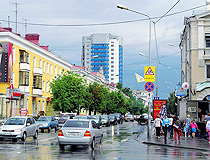
After the rain in the center of Kurgan
Author: Boris Busigin
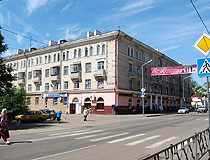
Architecture of Kurgan
Author: Oleg Savona
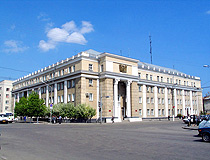
Sunny day in Kurgan
Author: Igor Guryanov
Kurgan - Features
Kurgan is located east of the Ural Mountains, in the southwest of the West Siberian Plain, in the middle basin of the Tobol River. The height above sea level is about 75 m. This city is considered the gateway to Siberia.
The climate of the city is temperate continental with cold, not snowy winters and hot, dry summers. The Ural Mountains prevent the passage of moist air masses. The average temperature in January is minus 15.2 degrees Celsius, in July - plus 19.8 degrees Celsius.
The most important sectors determining the development of the local industrial complex are mechanical engineering and metalworking, as well as the medical industry. The largest mechanical engineering companies are Kurgan Bus Plant, Kurgan Engineering Plant (BMP-2, BMP-3, etc.), Kurgan Road Equipment Plant (road construction and municipal vehicles).
Kurgan provides transport links between the European and Asian parts of Russia. The federal highway M51 “Irtysh” passes through the city connecting the cities of Chelyabinsk, Omsk, and Novosibirsk. The R327 highway connects Kurgan with Kostanay (Kazakhstan), the R354 highway connects it with Yekaterinburg.
The Trans-Siberian Railway passes through Kurgan connecting the cities of Moscow, Chelyabinsk, Omsk, Novosibirsk, Krasnoyarsk, and Vladivostok. The airport of Kurgan offers regular flights to Moscow.
A lot of beautiful old houses have been preserved in Kurgan. In total, there are more than 100 objects of cultural heritage including 4 objects of cultural heritage of federal significance. Most of the old houses can be seen on the streets of Sovetskaya, Kuibysheva, and Klimova that make up the historic city center.
Main Attractions of Kurgan
Kurgan Regional Museum of Local Lore. This museum has a rich collection of exhibits telling about the history, flora and fauna of the Urals, customs, lifestyle, culture of the peoples living in the region. There is a collection of fossils. In the historical part of the exposition, you can see archaeological artifacts dating from the Iron Age. Pushkina Street, 137.
Kurgan Regional Art Museum - one of the main cultural centers of Kurgan. The collection of the museum consists of almost 9 thousand works of artists, sculptors, graphic artists, masters of decorative art. The paintings created by P. Konchalovsky, A. Deineka, Yu. Razumovskaya, S. Luppov are exhibited here, as well as the collection of watercolors, in which the wonderful works of L. Bruni and A. Fonvizin stand out. Gorkogo Street, 129.
Museum of Aviation. The exposition is located on the territory of the Kurgan Airport. The most interesting exhibits are 15 civilian and military aircraft. Other exhibitions present flight simulators, uniforms of pilots, and various equipment. There are also separate exhibtions dedicated to the history of aviation with documents, photographs, and awards of pilots. Gagarina Street, 41.
House Museum of the Decembrists. The museum is located in the house where the Decembrist M.M. Naryshkin lived with his family from 1833 to 1837. As a result of restoration, you can see the 19th century interiors of the rooms of the owners of the house, living room, dining room, and library. For decades, its employees have been collecting a unique collection of items that once belonged to the Naryshkin family. A lot of valuable exhibits were handed over by their descendants: dishes, clothes, and home textiles. Klimova Street, 80A.
Alexander Nevsky Cathedral (1896-1902) - the main Orthodox church in Kurgan and Kurgan Oblast. The architectural style of this building combines Romanesque and Old Russian traditions, creatively redesigned in the manner of “brick architecture” popular in those days. Volodarskogo Street, 42.
Old Fire Station (1882). A wooden 27-meter high hexagonal watch-tower of this fire station is one of the symbols of Kurgan and a very picturesque monument of architecture. On the top of the tower you can see a mannequin firefighter. Kuybysheva Street, 62.
The most interesting old houses of Kurgan are The House of Engineer F.F. Ostapets (one of the most beautiful wooden buildings in Kurgan resembling a small castle, Pushkina, 85), The House of A.A. Danilushkin (a unique example of an apartment building in the “Russian style” of the late 19th - early 20th centuries, Gorkogo Street, 170), The House of Merchant K.M. Dunaev (one of the most elegant wooden houses in Kurgan, Klimova Street, 47), The Estate of Merchants Berezins (the only urban stone manor east of the Urals that has preserved a closed courtyard with outbuildings and a central house in the style of Russian late classicism, Kuybysheva Street, 59).
Also Kurgan has a philharmonic society (Troitskaya Square, 1A), a drama theater (Gogolya Street, 58), and a puppet theater (Sovetskaya, 104).



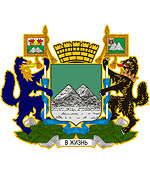
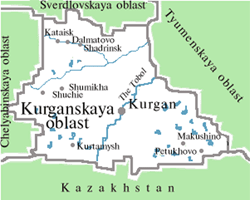



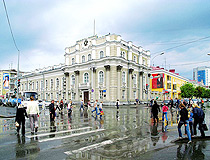
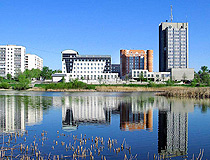
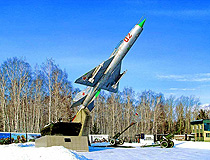
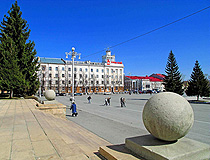
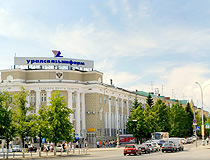
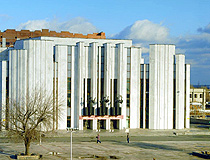
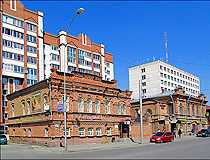
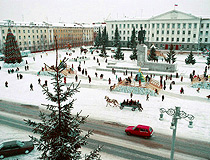
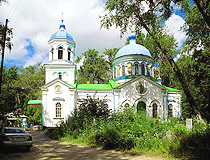
The comments of our visitors
All 5 comments